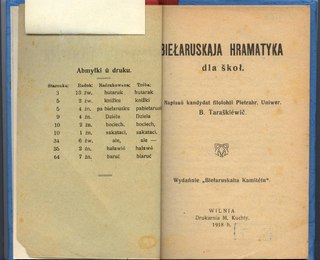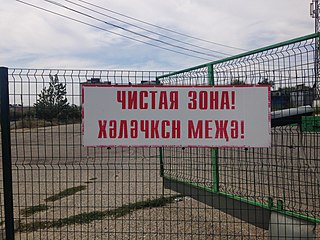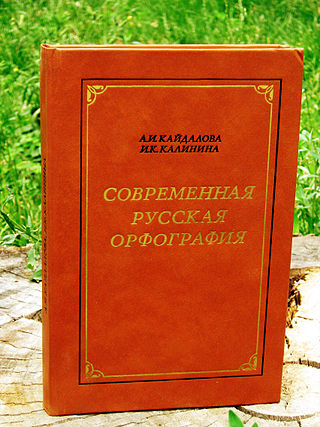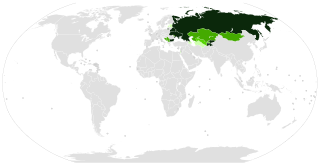This article has multiple issues. Please help improve it or discuss these issues on the talk page . (Learn how and when to remove these template messages)
|
The orthography of the Belarusian language was reformed in 1933 during the Soviet era.
This article has multiple issues. Please help improve it or discuss these issues on the talk page . (Learn how and when to remove these template messages)
|
The orthography of the Belarusian language was reformed in 1933 during the Soviet era.

In grammar, the genitive case is the grammatical case that marks a word, usually a noun, as modifying another word, also usually a noun—thus indicating an attributive relationship of one noun to the other noun. A genitive can also serve purposes indicating other relationships. For example, some verbs may feature arguments in the genitive case; and the genitive case may also have adverbial uses.

Belarusian is an East Slavic language. It is one of the two official languages in Belarus, alongside Russian. Additionally, it is spoken in some parts of Russia, Lithuania, Latvia, Poland, and Ukraine by Belarusian minorities in those countries.

A breve is the diacritic mark ◌̆, shaped like the bottom half of a circle. As used in Ancient Greek, it is also called brachy, βραχύ. It resembles the caron but is rounded, in contrast to the angular tip of the caron. In many forms of Latin, ◌̆ is used for a shorter, softer variant of a vowel, such as "Ĭ", where the sound is nearly identical to the English /i/.
Ŭ or ŭ is a letter in the Belarusian Latin alphabet used since 1840/1845, based on u. It is also used in the Esperanto alphabet, publicly presented in 1887, and formerly in the Romanian alphabet. The accent mark (diacritic) is known as a breve.

The Russian alphabet is the script used to write the Russian language. It comes from the Cyrillic script, which was devised in the 9th century for the first Slavic literary language, Old Slavonic. Initially an old variant of the Bulgarian alphabet, it became used in the Kievan Rusʹ since the 10th century to write what would become the modern Russian language.

The Belarusian Latin alphabet or Łacinka for the Latin script in general is the common name for writing Belarusian using Latin script. It is similar to the Sorbian alphabet and incorporates features of the Polish and Czech alphabets. Today, Belarusian most commonly uses the Cyrillic alphabet.
Russian grammar employs an Indo-European inflexional structure, with considerable adaptation.

Kalmyk Oirat, commonly known as the Kalmyk language, is a variety of the Oirat language, natively spoken by the Kalmyk people of Kalmykia, a federal subject of Russia. In Russia, it is the standard form of the Oirat language, which belongs to the Mongolic language family. The Kalmyk people of the Northwest Caspian Sea of Russia claim descent from the Oirats from Eurasia, who have also historically settled in Mongolia and Northwest China. According to UNESCO, the language is "Definitely endangered". According to the Russian census of 2010, there are 80,500 speakers of an ethnic population consisting of 183,000 people.

Ghe with upturn, also known as Ge or G, is a letter of the Cyrillic script. It is part of the Ukrainian alphabet, the Pannonian Rusyn alphabet and both the Carpathian Rusyn alphabets, and also some variants of the Urum and Belarusian alphabets. In these languages it is usually called ge, while the letter it follows, ⟨Г г⟩ is called he. In the Unicode system for text encoding, this letter is called ghe with upturn.

Russian orthography is an orthographic tradition formally considered to encompass spelling and punctuation. Russian spelling, which is mostly phonemic in practice, is a mix of morphological and phonetic principles, with a few etymological or historic forms, and occasional grammatical differentiation. The punctuation, originally based on Byzantine Greek, was in the seventeenth and eighteenth centuries reformulated on the models of French and German orthography.

The soft sign is a letter in the Cyrillic script that is used in various Slavic languages. In Old Church Slavonic, it represented a short or reduced front vowel. However, over time, the specific vowel sound it denoted was largely eliminated and merged with other vowel sounds.

The Ukrainian alphabet is the set of letters used to write Ukrainian, which is the official language of Ukraine. It is one of several national variations of the Cyrillic script. It comes from the Cyrillic script, which was devised in the 9th century for the first Slavic literary language, called Old Slavonic. In the 10th century, it became used in Kievan Rus' to write Old East Slavic, from which the Belarusian, Russian, Rusyn, and Ukrainian alphabets later evolved. The modern Ukrainian alphabet has 33 letters in total: 20 consonants, 2 semivowels, 10 vowels and 1 palatalization sign. Sometimes the apostrophe (') is also included, which has a phonetic meaning and is a mandatory sign in writing, but is not considered as a letter and is not included in the alphabet.

The letter Ъ ъ of the Cyrillic script is known as er golyam in the Bulgarian alphabet, as the hard sign in the modern Russian and Rusyn alphabets, as the debelo jer in pre-reform Serbian orthography, and as ayirish belgisi in the Uzbek Cyrillic alphabet. The letter is called back yer or back jer and yor or jor in the pre-reform Russian orthography, in Old East Slavic, and in Old Church Slavonic.

The Belarusian alphabet is based on the Cyrillic script and is derived from the alphabet of Old Church Slavonic. It has existed in its modern form since 1918 and has 32 letters. See also Belarusian Latin alphabet and Belarusian Arabic alphabet.
The grammar of Ukrainian describes its phonological, morphological, and syntactic rules. Ukrainian has seven cases and two numbers for its nominal declension and two aspects, three tenses, three moods, and two voices for its verbal conjugation. Adjectives agree in number, gender, and case with their nouns.
The phonological system of the modern Belarusian language consists of at least 44 phonemes: 5 vowels and 39 consonants. Consonants may also be geminated. There is no absolute agreement on the number of phonemes; rarer or contextually variant sounds are included by some scholars.

Numerous Cyrillic alphabets are based on the Cyrillic script. The early Cyrillic alphabet was developed in the 9th century AD and replaced the earlier Glagolitic script developed by the Byzantine theologians Cyril and Methodius. It is the basis of alphabets used in various languages, past and present, Slavic origin, and non-Slavic languages influenced by Russian. As of 2011, around 252 million people in Eurasia use it as the official alphabet for their national languages. About half of them are in Russia. Cyrillic is one of the most-used writing systems in the world. The creator is Saint Clement of Ohrid from the Preslav literary school in the First Bulgarian Empire.

Taraškievica or Belarusian Classical Orthography is a variant of orthography of the Belarusian language, based on the literary norm of the modern Belarusian language, the first normalization of which was made by Branislaŭ Taraškievič in 1918, and was in official use in Belarus until the Belarusian orthography reform of 1933. Since 1933, Taraškievica has been used informally in Belarus and by the Belarusian diaspora abroad. In a more common sense Taraškievica is sometimes considered to be a linguistic norm.
In Russian grammar, the system of declension is elaborate and complex. Nouns, pronouns, adjectives, demonstratives, most numerals and other particles are declined for two grammatical numbers and six grammatical cases ; some of these parts of speech in the singular are also declined by three grammatical genders. This gives many spelling combinations for most of the words, which is needed for grammatical agreement within and (often) outside the proposition. Also, there are several paradigms for each declension with numerous irregular forms.
The Ukrainian orthography of 1933 is the Ukrainian orthography, adopted in 1933 in the capital of the UkrSSR, Kharkiv. It began the process of artificial convergence of Ukrainian and Russian language traditions of orthography. Some norms that were rejected due to their absence in the Russian orthography were returned to the Ukrainian orthography of 2019.